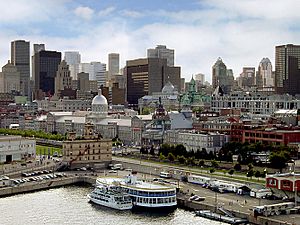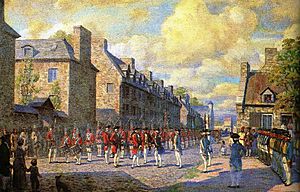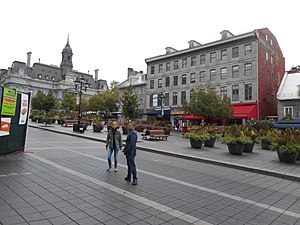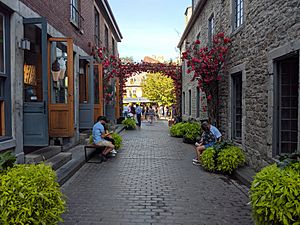Old Montreal facts for kids
Quick facts for kids
Old Montreal
|
|
|---|---|
|
Neighbourhood of Montreal
|
|
| Vieux-Montréal | |

View of Old Montreal from the Old Port of Montreal
|
|
| Country | Canada |
| Province | Quebec |
| City | Montreal |
| Borough | Ville-Marie |
| Area | |
| • Land | 0.71 km2 (0.27 sq mi) |
| Population
(2011)
|
|
| • Total | 4,531 |
| • Density | 6,381.7/km2 (16,529/sq mi) |
| • Change (2006-11) | |
| • Dwellings | 3,312 |
| Official name: Site patrimonial de Montréal | |
| Type: | Site patrimonial déclaré |
| Designated: | 1964-01-08 |
| Reference #: | 93528 |
Old Montreal (in French: Vieux-Montréal) is a very old and important neighbourhood in the city of Montreal, Quebec, Canada. It was started by French settlers in 1642 and was first called Fort Ville-Marie. Many buildings there are from the time of New France. This historic area gives its name to the larger part of the city called Ville-Marie.
Old Montreal is next to the Old Port of Montreal. It is bordered by McGill Street to the west, Ruelle des Fortifications to the north, rue Saint-André to the east, and the Saint Lawrence River to the south. Recently, the neighbourhood grew to include Rue des Soeurs Grises, Saint Antoine Street, and Saint Hubert Street. In 1964, a large part of Old Montreal was officially made a historic district by the government of Quebec.
Contents
History of Old Montreal
Early French Settlement

In 1605, Samuel de Champlain set up a fur-trading post in what is now Old Montreal. It was near the Saint Lawrence River. However, the settlers had to leave because of attacks from the Iroquois people.
The city of Montreal officially began in 1642. It was first known as Ville-Marie. The founder, Paul Chomedey de Maisonneuve, built a fort in 1643. This fort was the main base for the Société Notre-Dame de Montréal. This group wanted to teach First Nations people about Christianity and build a Christian settlement in New France.
French Colony Life
In 1663, the Sulpician priests took over the management of Montreal. King Louis XIV of France then took direct control of the colony. The Sulpicians were given the island of Montreal. They had to live there and help it grow by farming the land.
In 1665, the King sent soldiers to help protect the colony. François Dollier Casson then planned the first streets, like Rue Notre-Dame, Rue Saint-Paul, and Rue Saint-Jacques. Important buildings from this time include the Hôtel-Dieu de Montréal and the Saint-Sulpice Old Seminary.
In the early 1700s, the name "Montreal" (which came from the mountain Mont-Royal) slowly replaced "Ville-Marie." The arrival of Marguerite Bourgeoys in 1657 and other religious groups helped keep the settlement Catholic.
Walls were built around Montreal in 1717 to protect it from a British invasion and allow for future growth. However, many wooden houses inside the walls led to big fires. In 1721, France ordered that new buildings be made of stone, but this rule was not always followed.
British Control and Changes

After the Seven Years' War, Canada (New France) became a British colony in 1763. British rule brought many changes to Old Montreal. Several big fires destroyed much of the city, which meant it had to be rebuilt. For example, in 1765 and 1768, almost half of the city's buildings were burned down.
In 1803, another large fire destroyed a prison, a church, and many houses. A new market square, now called Place Jacques-Cartier, was created on the land where some of these buildings once stood. The Montreal City Hall was later built on the site of old Jesuit gardens in 1873.
In 1804, the walls around Montreal were torn down. This made Old Montreal bigger and easier to access from other areas. The 1800s saw many Scottish merchants become very successful. Old Montreal became less of a place for homes and more for business. Wealthy merchants built fancy houses closer to Mount Royal.
Saint Jacques Street became the financial heart of Montreal. Big banks like the Bank of Montreal and the Royal Bank of Canada were built there. Many of these important buildings were designed by British architects. The look of Old Montreal changed with the new Victorian style buildings, which were different from the older French stone buildings.
Decline, Preservation, and Renewal
Old Montreal continued to grow in the early 1900s with new buildings like the Aldred Building. But the Great Depression in 1929 caused problems. Many businesses left when the port moved further east. The city center also moved north, and fewer people lived in Old Montreal. This made the area feel empty and unsafe at night.
As cars became more common, Old Montreal's streets became very busy. City planners even thought about tearing down old buildings to make wider roads. A plan for a highway along the river would have destroyed much of the historic area.

However, an architect named Daniel van Ginkel helped save the district in the 1960s. He convinced officials to stop the highway plan. In 1964, most of Old Montreal was declared a historic district.
Today, Old Montreal is thriving again. More people live there, and many old buildings have been turned into hotels. There are now about 20 hotels, mostly in restored buildings. Tourists and residents make the area lively, especially at night. The city has also spent money to improve the area, like redesigning Place Jacques-Cartier. Old Montreal's history is now seen as its biggest strength, making it a top tourist spot in Montreal.
Architecture and Urban Planning
Old Montreal is a very popular place for tourists. Some of its buildings are from the 1600s, making it one of the oldest city areas in North America.
In the eastern part of the old city, you can find the Montreal City Hall, Bonsecours Market, and Notre-Dame-de-Bon-Secours Chapel. There are also old colonial homes like the Château Ramezay. Further west, Place d'Armes is home to the impressive Notre-Dame Basilica and the Saint-Sulpice Seminary, which is the oldest building still standing in Montreal.

Saint Jacques Street is lined with old bank buildings from when it was Canada's financial center. The Aldred Building and the New York Life Building (Canada's oldest skyscraper) are also here.
In the southwest, you can visit the Pointe-à-Callière to see remains of Montreal's first settlement. The old town's buildings and cobbled streets have been kept or fixed up to look like they did long ago. Horse-drawn calèches (carriages) also help keep this historic feeling alive.
The Old Port is along the riverbank. It has fun recreational areas, museums, and attractions. Large cruise ships also dock here, bringing many visitors.
Champ de Mars
Champ de Mars is a big public space between Montreal City Hall and the Ville-Marie Expressway. You can see downtown Montreal and Chinatown from here. It's special because you can still see parts of the old city walls there.
Transportation
You can get to Old Montreal from downtown using the Underground City. Several STM bus routes serve the area. You can also use the Metro at the Champ-de-Mars, Place-d'Armes, and Square-Victoria-OACI stations. In the summer, you can take ferries to Longueuil on the south shore. There are also many bicycle paths.
See also
 In Spanish: Vieux-Montreal para niños
In Spanish: Vieux-Montreal para niños





